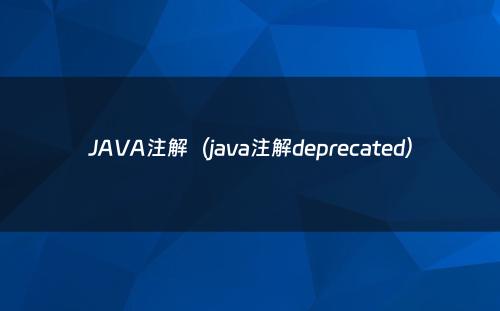网站首页 > java教程 正文
注解的定义
注解是元数据,即一种描述数据的数据。所以,可以说注解就是源代码的元数据
Annotation是一种应用于类、方法、参数、变量、构造器及包声明中的特殊修饰符

注解的作用
生成文档。这是最常见的,也是java 最早提供的注解。
常用的有@see @param @return
跟踪代码依赖性,实现替代配置文件功能。
在编译时进行格式检查。
如@override 放在方法前,如果你这个方法并不是覆盖了超类方法,则编译时就能检查出。
注解的分类
- 标准注解 包括 Override, Deprecated, SuppressWarnings,标准注解是指 Java 自带的几个注解,上面三个分别表示重写函数,函数已经被禁止使用,忽略某项 Warning
- 元注解 (注解的注解)
@Retention, @Target, @Inherited, @Documented,元注解是指用来定义注解的注解
@Target说明了Annotation所修饰的对象范围
Annotation可被用于 packages、types(类、接口、枚举、Annotation类型)、类型成员(方法、构造方法、成员变量、枚举值)、方法参数和本地变量(如循环变量、catch参数)。在Annotation类型的声明中使用了target可更加明晰其修饰的目标
作用:用于描述注解的使用范围(即:被描述的注解可以用在什么地方)
取值(ElementType)有:
1.CONSTRUCTOR:用于描述构造器
2.FIELD:用于描述域
3.LOCAL_VARIABLE:用于描述局部变量
4.METHOD:用于描述方法
5.PACKAGE:用于描述包
6.PARAMETER:用于描述参数
7.TYPE:用于描述类、接口(包括注解类型) 或enum声明
使用实例:
@Target(ElementType.TYPE)
public @interface Table {
/**
* 数据表名称注解,默认值为类名称
* @return
*/
public String tableName() default "className";
}
@Retention定义了该Annotation被保留的时间长短:某些Annotation仅出现在源代码中,而被编译器丢弃;而另一些却被编译在class文件中;编译在class文件中的Annotation可能会被虚拟机忽略,而另一些在class被装载时将被读取(请注意并不影响class的执行,因为Annotation与class在使用上是被分离的)。使用这个meta-Annotation可以对 Annotation的“生命周期”限制。
作用:表示需要在什么级别保存该注释信息,用于描述注解的生命周期(即:被描述的注解在什么范围内有效)
取值(RetentionPoicy)有:
1.SOURCE:在源文件中有效(即源文件保留)
2.CLASS:在class文件中有效(即class保留)
3.RUNTIME:在运行时有效(即运行时保留)
Retention meta-annotation类型有唯一的value作为成员,
它的取值来自java.lang.annotation.RetentionPolicy的枚举类型值。
具体实例如下:
@Target(ElementType.FIELD)
@Retention(RetentionPolicy.RUNTIME)
public @interface Column {
public String name() default "fieldName";
public String setFuncName() default "setField";
public String getFuncName() default "getField";
public boolean defaultDBValue() default false;
}
Column注解的的RetentionPolicy的属性值是RUTIME,这样注解处理器可以通过反射,获取到该注解的属性值,从而去做一些运行时的逻辑处理
@Documented用于描述其它类型的annotation应该被作为被标注的程序成员的公共AP I,因此可以被例如javadoc此类的工具文档化。Documented是一个标记注解,没有成员。
@Target(ElementType.FIELD)
@Retention(RetentionPolicy.RUNTIME)
@Documented
public @interface Column {
public String name() default "fieldName";
public String setFuncName() default "setField";
public String getFuncName() default "getField";
public boolean defaultDBValue() default false;
}
@Inherited 元注解是一个标记注解,@Inherited阐述了某个被标注的类型是被继承的。如果一个使用了@Inherited修饰的annotation类型被用于一个class,则这个annotation将被用于该class的子类。
注意:@Inherited annotation类型是被标注过的class的子类所继承。类并不从它所实现的接口继承annotation,方法并不从它所重载的方法继承annotation。
当@Inherited annotation类型标注的annotation的Retention是RetentionPolicy.RUNTIME,则反射API增强了这种继承性。如果我们使用java.lang.reflect去查询一个@Inherited annotation类型的annotation时,反射代码检查将展开工作:检查class和其父类,直到发现指定的annotation类型被发现,或者到达类继承结构的顶层。
@Inherited
public @interface Greeting {
public enum FontColor { BULE,RED,GREEN};
String name();
FontColor fontColor() default FontColor.GREEN;
}
- 自定义注解
自定义注解表示自己根据需要定义的注解,定义时需要用到上面的元注解
使用@interface自定义注解时,自动继承了java.lang.annotation.Annotation接口,由编译程序自动完成其他细节。在定义注解时,不能继承其他的注解或接口。@interface用来声明一个注解,其中的每一个方法实际上是声明了一个配置参数。方法的名称就是参数的名称,返回值类型就是参数的类型(返回值类型只能是基本类型、Class、String、enum)。可以通过default来声明参数的默认值。
定义注解格式:
public @interface 注解名 {定义体}
注解参数的可支持数据类型:
1.所有基本数据类型(int,float,boolean,byte,double,char,long,short)
2.String类型
3.Class类型
4.enum类型
5.Annotation类型
6.以上所有类型的数组
Annotation类型里面的参数该怎么设定:
第一,只能用public或默认(default)这两个访问权修饰.例如,String value();这里把方法设为defaul默认类型;
第二,参数成员只能用基本类型byte,short,char,int,long,float,double,boolean八种基本数据类型和 String,Enum,Class,annotations等数据类型,以及这一些类型的数组.例如,String value();这里的参数成员就为String;
第三,如果只有一个参数成员,最好把参数名称设为"value",后加小括号.例:下面的例子FruitName注解就只有一个参数成员。
以下自定义一个Test注解,含有两个元素 id 和 description
mport java.lang.annotation.Documented;
import java.lang.annotation.Inherited;
import java.lang.annotation.Retention;
import java.lang.annotation.Target;
import java.lang.annotation.ElementType;
import java.lang.annotation.RetentionPolicy;
@Target(ElementType.METHOD)
@Retention(RetentionPolicy.RUNTIME)
@Documented
@Inherited
/*
* 定义注解 Test
* 注解中含有两个元素 id 和 description
* description 元素 有默认值 "no description"
*/
public @interface Test {
public int id();
public String description() default "no description";
}
使用上面自定义的Test注解
import java.lang.reflect.Method;
public class TestAnnotation {
@Test(id = 1, description = "hello method_1")
public void method_1() {
}
@Test(id = 2)
public void method_2() {
}
@Test(id = 3, description = "last method")
public void method_3() {
}
// 解析注解,将TestAnnotation类 所有被注解方法 的信息打印出来
public static void main(String[] args) {
Method[] methods = TestAnnotation.class.getDeclaredMethods();
for (Method method : methods) {
boolean hasAnnotation = method.isAnnotationPresent(Test.class);
// 判断方法中是否有指定注解类型的注解
if (hasAnnotation) {
// 根据注解类型返回方法的指定类型注解
Test annotation = method.getAnnotation(Test.class);
System.out.println("Test( method = " + method.getName() + " ,
id = " + annotation.id() + " , description = "+ annotation.description() + " )");
}
}
}
}
猜你喜欢
- 2024-09-21 Java基础:注解,改变了编程的体验
- 2024-09-21 人手必备!Java8中的注解,你必须知道的几点
- 2024-09-21 Java 进阶之 注解(java中注解如何实现的)
- 2024-09-21 java注解的使用(java注解的实现原理)
- 2024-09-21 不吹牛,撸个注解有什么难的(不吹牛的道理)
- 2024-09-21 终于弄懂了Spring@Component @Repository@Service的区别
- 2024-09-21 2020年最新Java全套教程注解(2020年最新兵役法)
- 2024-09-21 你知道Spring是如何处理注解的吗?
- 2024-09-21 注解梳理:深入理解Java注解类型(@Annotation)
- 2024-09-21 Java中的注解到底是如何工作的?(注解 java)
欢迎 你 发表评论:
- 12-02家庭路由器哪种比较好用(家庭路由器哪种比较好用2020年)
- 12-02怎样装电脑台式机(如何组装电脑台式机)
- 12-02u盘格式化后识别不出来怎么办
- 12-02win7系统怎么调节电脑屏幕亮度
- 12-02iphone14桌面下载(ios14下载桌面)
- 12-02硬盘恢复数据多少钱(硬盘恢复数据要多少钱)
- 12-02win7电脑恢复出厂(win7电脑恢复出厂设置怎么操作的)
- 12-02快手极速版下载app(11快手极速版下载安装)
- 最近发表
- 标签列表
-
- java反编译工具 (77)
- java反射 (57)
- java接口 (61)
- java随机数 (63)
- java7下载 (59)
- java数据结构 (61)
- java 三目运算符 (65)
- java对象转map (63)
- Java继承 (69)
- java字符串替换 (60)
- 快速排序java (59)
- java并发编程 (58)
- java api文档 (60)
- centos安装java (57)
- java调用webservice接口 (61)
- java深拷贝 (61)
- 工厂模式java (59)
- java代理模式 (59)
- java.lang (57)
- java连接mysql数据库 (67)
- java重载 (68)
- java 循环语句 (66)
- java反序列化 (58)
- java时间函数 (60)
- java是值传递还是引用传递 (62)

本文暂时没有评论,来添加一个吧(●'◡'●)